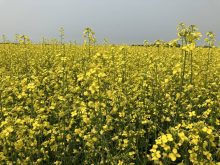China and Russia have signed a phytosanitary protocol for peas opening the door for competition in Canada’s top market.
However, that competition is not likely to be very intense in the inaugural year of the agreement, according to a Russian grain trader.
Alexander Gavrilov, head of the Asia trade desk with TH Sodrugestvo Ltd., said Russian farmers and traders need to meet numerous formal requirements before they can ship peas to China.
Read Also

U.S. bill could keep out Canadian truckers
The Protecting America’s Roads Act, which was tabled in the U.S. House of Representatives at the beginning of October, would “rid the country of illegal immigrant commercial truck drivers and ineligible foreign nationals.”
There are also numerous registrations that have to be checked by Russian authorities and confirmed by Chinese regulators.
“The next thing required is complete crop certification,” Gavrilov said in an email.
“It’s a complex thing similar to IP certification.”
The upshot is that there are processes that need to be implemented that will all take considerable time and effort.
“So my opinion is that there may be no export to China at all this year,” he said.
However, Chinese regulators may decide to provide exemptions or simplified access since Russia’s planting campaign is nearly over and the south will be harvesting in a month or so.
Russia’s pea production has been steadily climbing the past couple of decades. Farmers harvested 2.94 million tonnes of the crop in 2021.
That was more than Canada’s drought-reduced total of 2.26 million tonnes.
Gavrilov said the market expects in excess of three million tonnes of Russian production in 2022, but that will depend on yields in various regions of the country.
Agriculture Canada is forecasting 3.5 million tonnes of Canadian production. Moisture conditions have vastly improved in Saskatchewan and Manitoba.
However, Stat Publishing is reporting there is growing concern that some farmers in Western Canada may reduce their intended pea acres in favour of other crops like canola in regions where it is excessively wet.
Meanwhile, there is extreme drought in Montana, where about half of the U.S. pea crop is planted.
“Without timely rains during the growing season, Montana’s yields are at risk,” Stat said in a recent article.
If conditions don’t improve, U.S. pea production could fall to 594,000 tonnes, well below the early-season forecast of 792,000 tonnes, according to Stat.
An estimated 31 percent of Russia’s pea crop is grown in the central European part of the country and the Volga Valley, 29 percent in the south, 23 percent in the Urals and Siberia and the rest scattered around other regions of the country.
“If exporting to China will be successful, this geographical distribution might easily get shifted towards Siberia, as has happened with (flax) already,” said Gavrilov.
That would be bad news for Canada, said Neil Townsend, chief market analyst with FarmLink Marketing Solutions.
“It’s not something that we’d like to see from a Canadian standpoint. China has been a very good market for (Canadian) yellow peas,” he said.
“We’d prefer if Russia and China never spoke.”
The good news is that a lot of Russia’s peas are consumed domestically. They are widely used in Russian cuisine and are also a common feed ingredient in the country.
Exports over the past four years have ranged from 600,000 to 1.1 million tonnes.
Turkey, Pakistan, Bangladesh, India and the United Arab Emirates usually account for about half of Russia’s exports. They consume food grade peas, said Gavrilov.
Another 20 to 30 percent is shipped to the European Union, where they are mainly consumed for feed, especially in Italy.
Afghanistan and central Asia also buy some product.
Logistics to China will depend on the region where the peas are grown. At today’s prices any route is possible, he said.
There could be rail movement using container or hopper cars or there could be shipments by Handymax or even Panamax vessels from the Black Sea once all the formalities are sorted out.


















